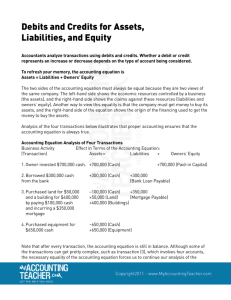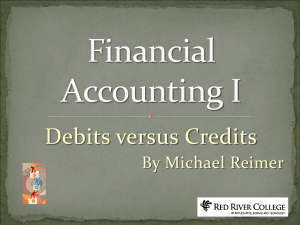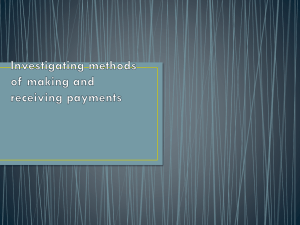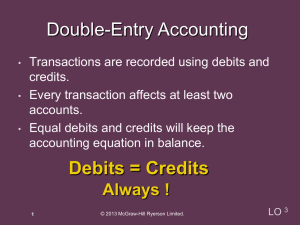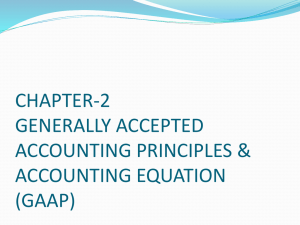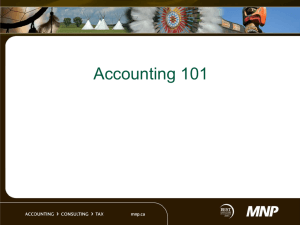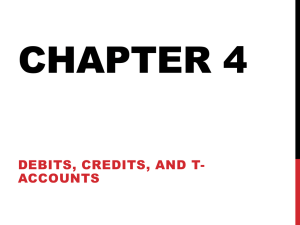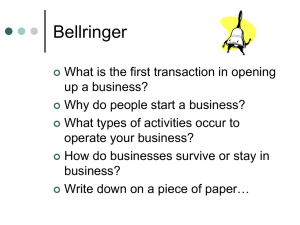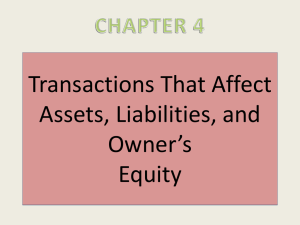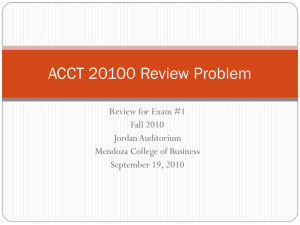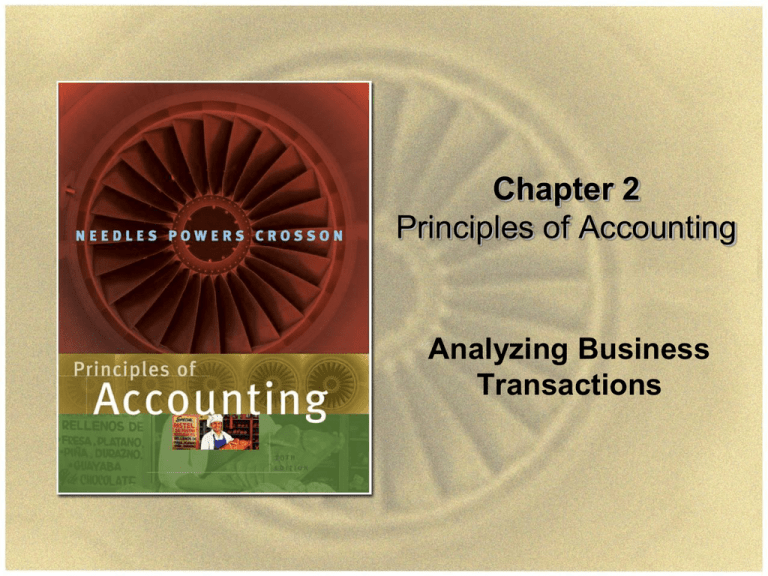
Chapter 2
Principles of Accounting
Analyzing Business
Transactions
Slide
1-1
Measurement Issues
Slide
1-2
Measurement Issues
Question: Are the following events recorded in the
accounting records?
Discuss
Event
Criterion
Record/
Don’t Record
Slide
1-3
Purchased a
computer.
product
design with
potential
customer.
Pay rent.
Is the financial position (assets, liabilities, or
stockholders’ equity) of the company changed?
Measurement Issues
Recognition
Note 1 - Summary of Significant Accounting Policies:
“We recognize sales for commercial airplane deliveries as
each unit is completed and accepted by the customer.”
Once Boeing reaches final agreements with customers, it
receives deposits from them for the airplanes they have
ordered.
Question: Is this event recorded in the accounting
records of Boeing?
Slide
1-4
Measurement Issues
Ethics and Measurement Issues
Slide
1-5
Accounting Transactions
Transaction Analysis
Assets
=
Liabilities
+
Owners’ Equity
Capital
Revenue
Slide
1-6
Withdrawal
Expense
The Account
Account
Record of increases and decreases
in a specific asset, liability, equity,
revenue, or expense item.
Debit = “Left”
Credit = “Right”
An Account can
be illustrated in a
T-Account form.
Slide
1-7
Account Name
Debit / Dr.
Credit / Cr.
Debit and Credit Procedures
Double-entry accounting system
Each transaction must affect two or more
accounts to keep the basic accounting equation
in balance.
Recording done by debiting at least one account
and crediting another.
DEBITS must equal CREDITS.
Slide
1-8
Debit and Credit Procedures
If Debits are greater than Credits, the account
will have a debit balance.
Account Name
Debit / Dr.
Transaction #1
$10,000
Transaction #3
8,000
Balance
Slide
1-9
$15,000
Credit / Cr.
$3,000
Transaction #2
Debit and Credit Procedures
If Credits are greater than Debits, the account
will have a credit balance.
Account Name
Debit / Dr.
Transaction #1
Balance
Slide
1-10
$10,000
Credit / Cr.
$3,000
Transaction #2
8,000
Transaction #3
$1,000
Dr./Cr. Procedures for Assets and Liabilities
Assets
Debit / Dr.
Credit / Cr.
Normal Balance
Liabilities – Credits
should exceed debits.
Chapter
3-23
Liabilities
Debit / Dr.
Credit / Cr.
Normal Balance
Chapter
3-24
Slide
1-11
Assets - Debits should
exceed credits.
The normal balance is on
the increase side.
Dr./Cr. Procedures for Stockholders’ Equity
Owner’s investments and
revenues increase owners’ equity
(credit).
Owners’ Equity
Credit / Cr.
Debit / Dr.
Withdrawals and expenses
decrease owners’ equity (debit).
Normal Balance
Chapter
3-25
Capital
Debit / Dr.
Chapter
3-25
Slide
1-12
Withdrawals
Credit / Cr.
Debit / Dr.
Normal Balance
Normal Balance
Chapter
3-23
Credit / Cr.
Dr./Cr. Procedures for Revenue and Expense
Revenue
Debit / Dr.
Credit / Cr.
Normal Balance
Chapter
3-26
Expense
Debit / Dr.
Normal Balance
Chapter
3-27
Slide
1-13
Credit / Cr.
The purpose of earning
revenues is to benefit the
owners.
The effect of debits and
credits on revenue accounts
is the same as their effect
on owners’ equity.
Expenses have the opposite
effect: expenses decrease
owners’ equity.
Debits and Credits Summary
Liabilities
Normal
Balance
Debit
Normal
Balance
Credit
Assets
Credit / Cr.
Normal Balance
Chapter
3-24
Owners’ Equity
Credit / Cr.
Debit / Dr.
Debit / Dr.
Debit / Dr.
Credit / Cr.
Normal Balance
Normal Balance
Chapter
3-23
Expense
Debit / Dr.
Revenue
Chapter
3-25
Credit / Cr.
Debit / Dr.
Normal Balance
Chapter
3-27
Slide
1-14
Credit / Cr.
Normal Balance
Chapter
3-26
Debits and Credits Summary
Balance Sheet
Asset = Liability + Equity
Debit
Credit
Slide
1-15
Income Statement
Revenue - Expense =
Debits and Credits Summary
Review Question
Debits:
a. increase both assets and liabilities.
b. decrease both assets and liabilities.
c. increase assets and decrease liabilities.
d. decrease assets and increase liabilities.
Slide
1-16
Debits and Credits Summary
Review Question
Accounts that normally have debit balances are:
a. assets, expenses, and revenues.
b. assets, expenses, and equity.
c. assets, liabilities, and withdrawals.
d. assets, withdrawals, and expenses.
Slide
1-17
Slide
1-18
Summary of the Accounting Cycle
1. Analyze business transactions
Slide
1-19
9.
2. Journalize the
transactions
8.
3. Post to ledger accounts
7. Prepare financial
statements
4. Prepare a trial balance
6.
5.
Accounting Cycle
Slide
1-20
Accounting
Cycle
Slide
1-21
Accounting
Cycle
Slide
1-22
Copyright
“Copyright © 2009 John Wiley & Sons, Inc. All rights reserved.
Reproduction or translation of this work beyond that permitted
in Section 117 of the 1976 United States Copyright Act without
the express written permission of the copyright owner is
unlawful. Request for further information should be addressed
to the Permissions Department, John Wiley & Sons, Inc. The
purchaser may make back-up copies for his/her own use only
and not for distribution or resale. The Publisher assumes no
responsibility for errors, omissions, or damages, caused by the
use of these programs or from the use of the information
contained herein.”
Slide
1-23

